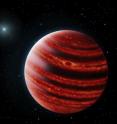Young, Jupiter-like planet discovered
A team of researchers has discovered a Jupiter-like planet within a young system that could provide a new understanding of how planets formed around our sun. The new planet, called 51 Eridani b, is the first exoplanet discovered by the Gemini Planet Imager (GPI), a new instrument operated by an international collaboration headed by Bruce Macintosh, a professor of physics in the Kavli Institute at Stanford University. It is a million times fainter than its star and shows the strongest methane signature ever detected on an alien planet, which should yield additional clues as to how the planet formed.
"The exploration of very young planetary systems that will evolve to look like our own has just begun," said Didier Saumon of Los Alamos National Laboratory, whose role was theoretical modeling and data analysis for the project.
"The Gemini Planet Imager is amazing new technology that has quickly discovered the first extrasolar analog of Jupiter, but much younger," Saumon said.
The Gemini Planet Imager was designed specifically for discovering and analyzing faint, young planets orbiting bright stars. The GPI is located on the 8-meter Gemini South Telescope in Chile, although the coordinating science teams are spread globally.
After GPI was installed on the telescope in Chile, the team set out to look for planets orbiting young stars. They've looked at almost a hundred stars so far. "This is exactly the kind of planet we envisioned discovering when we designed GPI," says James Graham, professor at UC Berkeley and Project Scientist for GPI.
The results are published in the current issue of Science.
As Saumon describes it, "this first analysis shows first, unequivocally, the presence of methane gas as the major carbon-bearing gas and water vapor in the atmosphere of the planet (which is otherwise dominated by hydrogen and helium, very much like our own Jupiter). The presence of methane, at the exclusion of other carbon-bearing gasses (such as carbon monoxide) is a first," he said.
Also Saumon notes that "the planet is cooler and less luminous than any other planet found by direct imaging (i.e. photographed) so far, but still hotter than Jupiter (800F versus -200F)."
"Many of the exoplanets astronomers have imaged before have atmospheres that look like very cool stars," said Macintosh, who led the construction of GPI and now leads the planet-hunting survey. "This one looks like a planet."
Using GPI to study more young solar systems such as 51 Eridani b, he said, will help astronomers understand the formation of our neighbor planets, and how common that planet-forming mechanism is throughout the universe.
Source: DOE/Los Alamos National Laboratory
Articles on the same topic
- Astronomers discover 'young Jupiter' exoplanetThu, 13 Aug 2015, 21:13:31 UTC
- Lawrence Livermore scientists discover new young planetThu, 13 Aug 2015, 21:01:54 UTC
- Astronomers discover 'young Jupiter' exoplanetThu, 13 Aug 2015, 20:13:54 UTC
- Jupiter-like planet discovered outside our solar systemThu, 13 Aug 2015, 20:13:41 UTC
- Astronomers discover 'young Jupiter' exoplanetThu, 13 Aug 2015, 18:57:41 UTC
- Astronomers discover 'young Jupiter' exoplanetThu, 13 Aug 2015, 18:57:21 UTC
- Methane, water enshroud nearby Jupiter-like exoplanetThu, 13 Aug 2015, 18:57:10 UTC
- Astronomers discover 'young Jupiter' exoplanetThu, 13 Aug 2015, 18:56:55 UTC
- Gemini-discovered world is most like JupiterThu, 13 Aug 2015, 18:56:44 UTC
Other sources
- 'Young Jupiter' exoplanet discovery: Q&A with astronomer Eric Nielsenfrom PhysorgMon, 17 Aug 2015, 14:30:45 UTC
- Found! 'Young Jupiter,' the Smallest Exoplanet Directly Seen by Telescopefrom Live ScienceFri, 14 Aug 2015, 22:30:20 UTC
- Distant "young Jupiter" could shed light on solar systemfrom CBSNews - ScienceFri, 14 Aug 2015, 16:00:24 UTC
- Young 'alien Jupiter' discoveredfrom BBC News: Science & NatureFri, 14 Aug 2015, 11:10:16 UTC
- Young, Jupiter-like planet discoveredfrom Science BlogThu, 13 Aug 2015, 23:10:09 UTC
- Astronomers photograph a baby Jupiter in another solar systemfrom Reuters:ScienceThu, 13 Aug 2015, 23:10:06 UTC
- Astronomers Discover 'Young Jupiter' Exoplanetfrom Newswise - ScinewsThu, 13 Aug 2015, 21:00:07 UTC
- Baby Jupiter discovered by new planet-hunting camerafrom CBC: Technology & ScienceThu, 13 Aug 2015, 19:20:08 UTC
- Astronomers discover 'young Jupiter' exoplanetfrom Science DailyThu, 13 Aug 2015, 18:50:36 UTC
- Found! 'Young Jupiter,' the Smallest Exoplanet Directly Seen by Telescopefrom Space.comThu, 13 Aug 2015, 18:50:29 UTC
- Methane, water enshroud nearby Jupiter-like exoplanetfrom PhysorgThu, 13 Aug 2015, 18:21:13 UTC
- Astronomers Glimpse a Young Jupiter, 51 Eridani bfrom Scientific AmericanThu, 13 Aug 2015, 18:20:53 UTC
- 'Young Jupiter' Discovered 100 Light-Years Awayfrom MSNBC: ScienceThu, 13 Aug 2015, 18:20:51 UTC
- 'Young Jupiter' 51 Eridani b: Why Directly Imaging an Exoplanet Is Big (Kavli Q+A)from Space.comThu, 13 Aug 2015, 18:20:27 UTC
- Exoplanet 51 Eridani b: A Red-Hot Young Jupiter Around Distant Star (Infographic)from Space.comThu, 13 Aug 2015, 18:20:26 UTC
- Astronomers Discover "Young Jupiter" Exoplanetfrom Newswise - ScinewsThu, 13 Aug 2015, 18:20:09 UTC
- Astronomers Discover 'Young Jupiter' Exoplanetfrom Newswise - ScinewsThu, 13 Aug 2015, 18:20:05 UTC
